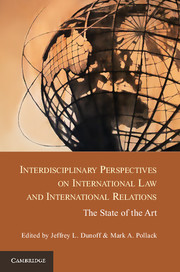 Interdisciplinary Perspectives on International Law and International Relations
Interdisciplinary Perspectives on International Law and International Relations Book contents
- Frontmatter
- Contents
- Contributors
- Acknowledgments
- Part I Introduction: Setting the Stage
- Part II Theorizing International Law
- Part III Making International Law
- 7 Flexibility in International Agreements
- 8 Hard and Soft Law
- 9 Nongovernmental Organizations in International Relations (Theory)
- 10 Regulatory Networks
- 11 Law-Making by International Organizations
- 12 Institutional Proliferation and the International Legal Order
- 13 Legitimacy in International Law and International Relations
- Part IV The Interpretation and Application of International Law
- Part V Enforcement, Compliance, and Effectiveness
- Conclusions
- Index
- References
9 - Nongovernmental Organizations in International Relations (Theory)
Published online by Cambridge University Press: 05 January 2013
- Frontmatter
- Contents
- Contributors
- Acknowledgments
- Part I Introduction: Setting the Stage
- Part II Theorizing International Law
- Part III Making International Law
- 7 Flexibility in International Agreements
- 8 Hard and Soft Law
- 9 Nongovernmental Organizations in International Relations (Theory)
- 10 Regulatory Networks
- 11 Law-Making by International Organizations
- 12 Institutional Proliferation and the International Legal Order
- 13 Legitimacy in International Law and International Relations
- Part IV The Interpretation and Application of International Law
- Part V Enforcement, Compliance, and Effectiveness
- Conclusions
- Index
- References
Summary
Non-state power is now a fact of international life. Nonetheless, the role of nongovernmental organizations (NGOs) in international relations remains undertheorized. A burgeoning social science literature relating to NGOs has emerged in recent years. However, this work tends to be narrow in scope, confronting discrete elements of NGO activity. This is unsurprising, given the novelty of much of the activity and the need for descriptive accounts in a range of contexts. International relations (IR) theorists have been late to the party. To the extent that IR theorists have attempted to situate NGOs in international process, for the most part, it has been relative to the state. This approach fails to recognize the consequentiality of NGO activity not directly implicating state action.
This chapter sketches a systematization of NGO activity relating to international relations. It describes four primary pathways for the exercise of NGO power: through and against states, international organizations (IOs), firms, and each other. Only by situating NGO power relative to state and non-state entities does the breadth and novelty of the NGO role in today's global decision-making come into full relief.
- Type
- Chapter
- Information
- Interdisciplinary Perspectives on International Law and International RelationsThe State of the Art, pp. 223 - 243Publisher: Cambridge University PressPrint publication year: 2012
References
- 2
- Cited by
